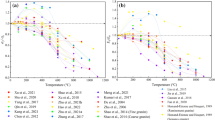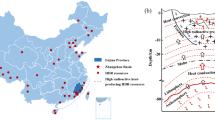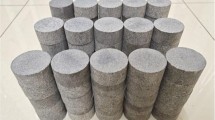Abstract
This paper presents a numerical modeling method that integrates a grain-growth model and Voronoi polygon configuration to investigate the thermal damage characteristics and fracture mechanism of granite under three distinct thermal conditions: rapid heating, slow heating, and cycle heating. The proposed method accurately simulates the intra-grain damage modes of mineral particles and the mechanical responses of granite. Through the simulation, it was observed that slow heating induces more significant deterioration compared to rapid heating, while cycle heating leads to wider crack openings and apparent brittle damage during the cooling phase. Furthermore, the peak strength and elastic modulus of granite demonstrate a significant decrease with increasing temperature under all three heating conditions. Notably, slow heating exhibits ductility characteristics in its post-peak residual strength. This study also analyzes the effects of different thermal conditions on the damage evolution pattern and cracking mechanism of rocks. It is found that slow heating generates a higher number of cracks with a broader distribution and intra-grain damage, whereas cycle heating results in severe cracks and fractures. The findings of this study have practical implications for preventing and controlling thermal disasters in deep rock engineering.
Article highlights
-
Developed 3DEC-GBM model integrating Grain-Growth and Voronoi for intra/transgranular behavior.
-
Conducted thermomechanical calculations considering mineral heterogeneity.
-
Compared crack development and macro-mechanical parameters under three heating conditions.
Similar content being viewed by others
Avoid common mistakes on your manuscript.
1 Introduction
With the rapid global development, the demand for the development of deep rock masses has significantly increased. Various large-scale rock projects, such as deeply buried underground oil storage reservoirs, deep burial of nuclear waste containment, deep oil extraction wells, and deep subway pipelines, have been designed to meet these demands (Bérest and Brouard 2003; Gautam et al. 2021; Kochkin et al. 2021; Chen et al. 2021). However, these projects are often exposed to the effects of high temperatures, leading to thermal hazards in deep subsurface spaces. These hazards pose significant challenges for construction, operation, and engineering maintenance in deep subsurface spaces, resulting in adverse effects. Figure 1 presents photographs depicting an underground coal mine fire in India (Tripathi et al. 2021), highlighting the importance of studying thermal hazards in deep rock masses. Therefore, the study of thermal hazards in deep rock masses is significant and has become one of the hot issues in the field of rock mechanics. In closed or abandoned mines, the presence of remaining coal mines can pose a risk of fire. The deeper sections of these abandoned mines are typically surrounded by granite. To ensure the safety and stability of these mines, it is crucial to conduct comprehensive research on the damage and fracture mechanism of the granite surrounding rocks under high temperatures. Understanding the properties and behavior of granite host rocks in high-temperature environments is essential for preventing potential fires and preserving the integrity of mine structures. Such research can offer valuable insights to develop effective safety measures and maintenance strategies.
Geological hazards caused by underground coal mine fires in India: a Obvious cracks and subsidence with coal fires underground; b Land disturbance with visible coal fires spewing flames (Tripathi et al. 2021)
Granite, characterized by its non-uniform composition, primarily consists of minerals such as quartz, feldspar, biotite, and others. At room temperature, granite exhibits good stability and rock strength. However, when subjected to high temperatures, the strength of granite undergoes a significant decrease (Kumari et al. 2019; Qin et al. 2020). This phenomenon can be attributed to the impact of temperature on the inter-particle strength within the rock, as well as the varying coefficients of thermal expansion among different minerals, which affect the volume expansion of each mineral. As a result, the non-uniform expansion of granite upon heating generates thermal stresses within the rock, leading to the initiation of microcracks and alterations in the rock's microstructure (Johnson et al. 1978; Zuo et al. 2017). Moreover, thermal stresses can cause the rupture of mineral grains, resulting in crack formation. Understanding the effect of granite's non-uniformity after heating on thermal damage and analyzing the thermal damage mechanism and mechanical response characteristics of granite are of great significance for the development of deep rock engineering and ensuring the stable operation of projects.
Rock thermal damage has garnered significant attention from scholars (Lei et al. 2019; Srinivasan et al. 2020; Yang et al. 2019), and indoor rock mechanics tests and numerical simulations have emerged as the primary methods for studying this phenomenon. Indoor rock mechanics tests enable in situ sampling and offer a more accurate representation of rock conditions at project sites. Huang et al. (2022) conducted dynamic mechanical response tests on fractured water-filled granite using the Split Hopkinson Pressure Bar (SHPB) technique in a laboratory. Du et al. (2020) studied the dynamic loading mechanics of sandstone cycles around open pit mines through indoor tests. Wang and Cai (2019) performed heating tests on granite and found that the final heating temperature significantly affected the uniaxial compression strength, while the heating rate did not. Ghasemi et al. (2020) observed the microstructure of rocks after heating, analyzing the role of various minerals in thermal damage. Luc Leroy et al. (2021) investigated high-temperature tests on granite, sandstone, and mudstone, concluding that high temperatures reduce the mechanical properties of rocks by over 75%. Ersoy et al. (2019) compared the strength changes of rocks after high-temperature heating under different cooling methods and fitted a predictable curve for rock damage strength after exposure to high temperatures. Freire-Lista et al. (2016) subjected granite to cycle heating and observed the microcracks produced using petrography and fluorescence microscopy. However, indoor rock mechanics tests have certain limitations, such as the discrete nature of rock specimens leading to significant test result dispersion. Therefore, it is necessary to observe the rock microstructure after the tests using techniques like electron microscopy. To address these limitations, scholars have turned to numerical simulation studies. For example, Zhao et al. (2022) used the PFC2D (Particle Flow Code in 2 Dimensions) method to investigate the effect of ultrasonic vibration on rock damage at high temperatures. Wang and Konietzky (2020) employed finite-difference simulations to evaluate differences in granite thermal damage under slow and rapid heating conditions. Vogler et al. (2020) conducted numerical simulations to study the damage process on the rock surface under rapid heating, exploring the impact of maximum heating rate and temperature. Wu et al. (2a, the blocks in the model are quite similar in terms of both shape and size, and the exact number of Voronoi blocks within the object cannot be explicitly specified.The Voronoi tessellation mothed defined as follows, being given a spatial domain \(D\in {\mathfrak{R}}^{n}\) and a set of seeds \(\left\{{S}_{i}\left({x}_{i},{w}_{i}\right),i=1,\cdots ,N\right\}\), each seed, \({S}_{i}\) is defined by its coordinates, \({x}_{i}\), Every seed \({S}_{i}\) is associated with a Voronoi cell \({C}_{i}\) as follows,
where \({d}_{E}\) is the Euclidean distance.
Comparison of Voronoi tessellation and Laguerre tessellation. a shows a cube composed of Voronoi cells as presented in the official example of 3DEC. In the 10 × 10 × 10 cube, a total of 1499 blocks are present. b shows the same 1499 blocks in a 10 × 10 × 10 cube generated by the grain-growth model in Neper
The Laguerre tessellation analytical is defined as follows, being given a spatial domain \(D\in {\mathfrak{R}}^{n}\) and a set of seeds \(\left\{{S}_{i}\left({x}_{i},{w}_{i}\right),i=1,\cdots ,N\right\}\), each seed, \({S}_{i}\) is defined by its coordinates, \({x}_{i}\), and a non-negative weight, \({w}_{i}\). Every seed \({S}_{i}\) is associated with a Laguerre cell \({C}_{i}\) as follows,
where, \({d}_{L}\) referred to as power distance and \({d}_{E}\) is the Euclidean distance. Since the Euclidean distance is defined with the coordinates, the power distance is mainly associated with the seed’s weight.
Neper is an open-source software that is primarily used for generating complex microstructures based on specific design criteria (Quey et al. 2011, 2018; Quey and Renversade 2018). It offers a diverse range of functionalities that enable the creation of models at various scales, making it possible to simulate intricate materials and structures. Additionally, Neper's computational capabilities allow for the optimization of these models, ensuring improved performance and efficiency.
The grain-growth model implemented in Neper is based on Laguerre tessellation, which provides a topological representation of a polycrystal composed of grain boundaries, triple junctions, and quadruple points. In comparison to Voronoi tessellation, Laguerre tessellation offers the advantage of describing any normal tessellation, irrespective of cell shape or arrangement. As shown in Fig. 2b, unlike Voronoi cells, Laguerre cells can exhibit variations in cell size, and their geometries are not limited by the equidistant nature of the faces in Voronoi cells. Consequently, Laguerre tessellation is considered both general and optimal for tessellations composed of convex cells.
In the context of representing rocks, Laguerre tessellation is considered more suitable than Voronoi tessellation. This is because Laguerre tessellation has the ability to account for the roundness and size distribution of granular particles, which are typically found in rocks. Unlike Voronoi tessellation, Laguerre tessellation provides a more accurate representation of the structure of rocks that consist of mineral particles with diverse shapes. Voronoi tessellation may encounter computational issues related to singular points and boundary points, whereas Laguerre tessellation, with its spherical structure, is better equipped to handle such situations. Furthermore, Laguerre tessellation allows for the generation of structures through 2D planar projections and 3D spherical cuts, which reduces the computational complexity involved in generating 3D structures compared to Voronoi tessellation.
2.2 Two-scale tessellation in Neper
The Voronoi polygon rule is a mathematically based geometric method that connects the midpoints of the sides of a polygon. The triangular division method, often resulting in relatively smooth sections of damage, is more suitable for simulating shear damage. On the other hand, the Voronoi polygon damage approach better represents the failure mode of rocks (Ghazvinian et al. 2014).
This geometric computational model has been implemented in several computational software packages. In this study, a two-scale model configuration approach is utilized to simulate both intra-grain damage within the granite and the destruction of the crystals themselves. Figure 3 illustrates the potential rupture pattern between crystals. In traditional block discrete element approaches, the blocks do not undergo damage, making it challenging to simulate intra-grain damage in tests. The Voronoi polygon generated in the simulation software exhibits an approximate hexagonal shape and relatively similar sizes. Granite is an inhomogeneous rock concerning both mineral composition and grain size. The model generated using this method in our study can accurately reflect the geological structure of granite. The proportions of the three main minerals in typical granite are very similar. Quartz minerals account for approximately 25%-30%, feldspar minerals account for about 60%, biotite minerals account for less than 10%, and other minerals account for less than 2% (Li et al. 2019, Full size image
After conducting multiple tests and considering computational limitations, it was found that using a large number of blocks (more than 2000) leads to an enormous matrix and requires several days to complete calculations. However, if the number of blocks is less than 50, the representation of inter-grain and intra-grain damage becomes inadequate, even though the calculations can be completed quickly. It is acknowledged that increasing the number of units improves the accuracy of describing thermal damage in rocks. Nevertheless, the three-dimensional 3DEC thermal coupling calculation suffers from slow calculation efficiency. Taking into account the limitations of computer computing power, the author conducted a series of tests and selected the 30X4 model, the random distribution of properties (RDP) method was used to define each group as different mineral properties. This model ensures non-uniformity of the model while better restoring the mechanical strength of granite and describing damage between and within particles. It should be noted that, from a mineralogical perspective, the particle size in this study is relatively large.
2.3 Parameters setting
The primary purpose of the mechanical parameter setting is to perform accurate simulation calculations of the contact to obtain simulation results consistent with the rock mechanics test. The parameter setting mainly has the following parameters to be set, namely: \({JK}_{n}\), \({JK}_{s}\), \({JK}_{n}/{JK}_{s}\), \({JC}_{m}\), \({J\phi }_{m}\), \({J\sigma }_{tm}\), \({JC}_{r}\), \({J\phi }_{r}\), \({J\sigma }_{tr}\). Where \({JK}_{n}\) And JKs denote normal and shear stiffness of grain contact, respectively; \({JC}_{m}\) and \({JC}_{r}\) denote cohesion of contact with Mohr–Coulomb and residual, respectively; \({J\phi }_{m}\) and \({J\phi }_{r}\) denote friction angles of and contact with Mohr–Coulomb and residual, respectively; \({J\sigma }_{tm}\) and \({J\sigma }_{tr}\) denote tensile strength of and contact with Mohr–Coulomb and residual, respectively. Regarding the mechanical calculation part, the flow chart for setting the GBM parameters of 3DEC is shown in Fig. 6.
Process for parameter setting for 3DEC-GBMs (modified from Wang and Cai 2019)
There are two main parts to the setting of mechanical parameters. Firstly, the adjustment of deformation parameters. The Poisson's ratio is only positively related to \({JK}_{n}/{JK}_{s}\). The value of \({JK}_{n}\) is fixed, and the ratio of \({JK}_{n}/{JK}_{s}\) is adjusted to satisfy the Poisson's ratio of the rock. The next step is to adjust the modulus of elasticity, which is still adjusted with the UCS simulation. The magnitude of the elastic modulus is positively proportional to the value of \({JK}_{n}\), and the result of the calculation is adjusted by adjusting the magnitude of \({JK}_{n}\) until it satisfies the elastic modulus of the rock (Wang and Cai 2018, 2019). The second part is the mechanical parameters, mainly the adjustment of tensile strength and cohesion friction angle. The simulation of tensile strength is proportional to the tensile strength parameter, and the cohesion and friction angle is determined by using direct tension simulation and triaxial compression and plotting the envelope, respectively. A series of adjustments were made to enable the simulation results to meet the experimental results. The results of experimental data from previous studies were selected (Yujie et al. 2020), as shown in Table 2. After parameter setting, nine types of contact were used in this study, and the specific values are shown in Table 3. After testing, combined with the results of previous studies, the residual strengths were all obtained as constant values. The parameter adjustment process for heterogeneous models is relatively more complex. Currently, the most recognized method is to adjust the parameters of each mineral individually until it meets the experimentally measured mechanical performance indicators. The average value of the two minerals is then taken at the contact where they touch each other. Regarding the contact parameters within minerals, there have been limited studies conducted thus far. Previous studies have commonly used values that establish larger internal contact parameters compared to the contact parameters between particles. In this study, we have referred to previous research and set the contact parameters inside the particles to be 1.5 times the basic parameters between particles (Wang and Cai 2018).
Where Q, F, B represent quartz, feldspar, biotite respectively. “in” denotes the contact parameters of intra-grains and “out” denotes the contact parameters of inter-grain.
Solving the thermal problem requires reconstructing the stress–strain equation, which requires subtracting the strain portion due to heat from the total strain. Thermal expansion does not contribute to angular variation in isotropic materials, so thermal expansion does not affect the shear strain increment. The incremental thermal strain is related to the coefficient of thermal expansion, which gives the equation:
where \({\alpha }_{t}\) denote coefficient of thermal expansion; \(\Delta T\) denote temperature difference variation; \({\delta }_{ij}\) denote the Kronecker factor.
From the above calculation of strain, the thermal stress coupling calculation can be obtained (Itasca Consulting Group 2019):
where \(K\) denotes bulk modulus,
3DEC allows only one-way thermal coupling to occur. Temperature changes can cause thermal strain and, thus, thermal stress.






















